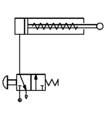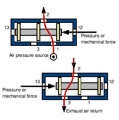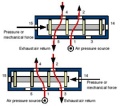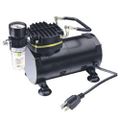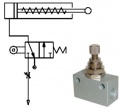Pneumatics: Difference between revisions
From DT Online
m (Added link) |
(Added Template) |
||
| Line 30: | Line 30: | ||
---- | ---- | ||
{{Pneumatic Actuators Buyers Guide}} | |||
[[Category:Secondary]] | [[Category:Secondary]] | ||
[[Category:Primary]] | [[Category:Primary]] | ||
Revision as of 17:56, 26 June 2016
Pneumatics involves the controlled use of compressed air. When used correctly, compressed air is a safe form of stored (potential) energy. It is put to a wide variety of uses such as dentists drills, automatic doors and hammer drills used at roadworks.
Pneumatic systems typically involve a source of compressed air being controlled by valves and causing output devices such as cylinders to operate in a controlled way.
The compressed air is typically obtained from a Compressor, which is usually driven by an electric motor or an internal combustion engine.
Air is routed through pipes to Valves which control the routing of the compressed air. Valves may be operated by a range of Actuators including levers, rollers and solenoids.
The air is then passed on to cylinders which convert the energy in the compressed air into linear motion and do useful work.
Finally, the used compressed air is released into the atmosphere as Exhaust.
During the course of the above, the compressed air may pass through filters and lubricators to clean the air and add lubricant to ensure that equipment has a long and reliable working life. It may also pass through regulators to control the amount of pressure available in the system.
Safety Point!
Safety is of the utmost importance when handling compressed air. If compressed air enters the body it can kill. Never use your finger to detect if compressed air is present, and always keep compressed air away from your eyes, nose, mouth etc.
As well as direct danger from the compressed air, pneumatic pistons can move quickly and with a great deal of force, so always be careful to keep fingers etc. away from live pneumatic systems.
When connecting pneumatic circuits, make sure that all connections are secure before finally connecting your circuit to the compressed air supply.
 |
 |
 |
 |
 |
 |
 |
 |
| Air Compressor |
4mm Air Line Connectors |
4mm Airline Adaptors |
Air Line Manifold |
Pneumatic Mechanical Valve |
Pneumatic Logic Air Valves |
Pneumatic Actuating Cylinders |
Pneumatic Construction Kits |
Subcategories
This category has the following 2 subcategories, out of 2 total.
Pages in category "Pneumatics"
The following 5 pages are in this category, out of 5 total.
Media in category "Pneumatics"
The following 19 files are in this category, out of 19 total.
- 3-2ValveSingleActingCylinder.gif 248 × 280; 1 KB
- 3pcyl.gif 600 × 200; 25 KB
- 5-2ValveDoubleActingCylinder.gif 248 × 280; 1 KB
- 5pcyl.gif 599 × 157; 12 KB
- AirPressureMeasurement.jpg 500 × 358; 24 KB
- MeasurePressure-AirFlow.jpg 277 × 142; 6 KB
- MeasurePressure-NoAirFlow.jpg 200 × 145; 5 KB
- PneumaticCylinderDimensions.jpg 500 × 215; 15 KB
- PneumaticDiaphragmActivator.jpg 237 × 115; 7 KB
- Pneumatics3-2valve.jpg 300 × 303; 14 KB
- Pneumatics5-2valve.jpg 300 × 265; 15 KB
- PneumaticsCompressor.jpg 500 × 500; 19 KB
- PneumaticsDoubleActingCylinder.jpg 583 × 133; 13 KB
- PneumaticsFlowControlValve.jpg 376 × 339; 12 KB
- PneumaticsFlowControlValveAdjustable.jpg 100 × 43; 2 KB
- PneumaticsFlowControlValveFixed.jpg 100 × 43; 2 KB
- PneumaticsSingleActingCylinder.jpg 600 × 133; 14 KB
- PneumaticsSingleActingCylinderDiagram.jpg 298 × 83; 7 KB
- PneumaticTimeDelayReservoir.jpg 296 × 360; 14 KB
